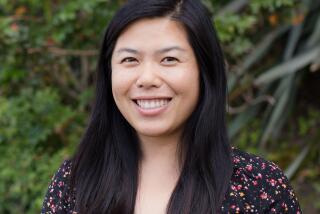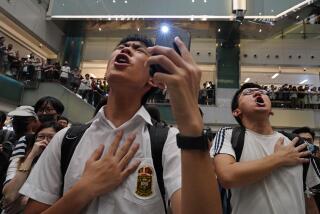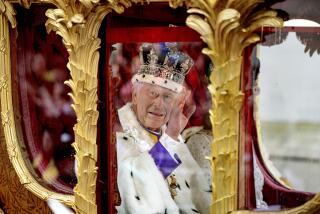Sun Never Sets on Some Customs
HONG KONG — On the first day back in court after Hong Kong became part of China, the barristers were confused. “Do we still call you Your Lordship?” a bewigged defense lawyer asked the judge, who said he would have to look that issue up.
The answer returned by His Lordship after a brief recess? Yes.
While Hong Kong is rapidly adapting to its new role as a part of China, changing its royal crests and Union Jacks for Chinese national seals and red flags, some things will remain unexpectedly English. Even under Chinese rule, Hong Kong’s court system and its English common law accouterments will stay the same, down to the terms of address, barristers’ black robes and white-winged collars and judges’ powdered horsehair wigs.
Rolls-Royces and double-decker buses will still rumble down boulevards with names such as Queen’s Road or streets dubbed in honor of past colonial figures.
There is: Possession Street, which begins near the point where British ships first landed; Jardine’s Lookout, a hill from which watchmen kept an eye peeled for the opium-laden clipper ships of Jardine Matheson’s trading house; and Eliot Crescent, named for the captain who oversaw the first ignominious Opium War in which Britain won Hong Kong from China.
The only British leader not to be recognized this way is Britain’s last governor, Chris Patten, who said he didn’t expect much to bear his name after five years of acrimony with Beijing. “Perhaps the sewage plant,” he quipped before he left July 1.
Patten’s old residence--the stately white Government House, overlooking downtown Hong Kong--will be preserved as a museum and site of some official functions.
In the room where Prince Charles knighted deserving subjects of the queen the day before the British left Hong Kong, Tung Chee-hwa, the territory’s new Beijing-approved leader, invested local patriots the day after with the post-hand-over equivalent: the Grand Bauhinia Medal.
But Government House is considered too infused with colonial airs for Hong Kong’s new chief executive. “It has bad feng shui”--or vibes--Tung declared, announcing that he would make his own apartment--on MacDonnell Road, named after the seventh colonial governor--the official residence.
A bronze statue of Queen Victoria--albeit with her nose bashed in by a “performance artist” last year--still reigns over Victoria Park, though the place is now known as Hong Kong Park. Figures of royalty, meantime, have been removed from Statue Square in central Hong Kong.
But a frock-clad effigy of Sir Thomas Jackson still stands there in the shadow of the Hongkong and Shanghai Bank he founded in 1886. The bank is now one of the world’s largest, and Jackson is retained, perhaps not as a colonial figure but as a symbol of Hong Kong’s innate commercial impulse.
The last bastion of crusty colonialism seems to be the Hong Kong Royal Yacht Club, which stubbornly retained the “Royal” part of its title in English, though not in Chinese. Members there can sip gin and tonic--a drink originated by the colonials, who discovered that the quinine in the tonic water helped stave off malaria in the tropics--and discuss their yachts and pleasure junks bobbing off Queen’s Pier, and the now-fading glories of the empire.
In Hong Kong linger not only veterans of old colonies but also old hands from past wars. They gather once a year at the Cenotaph in central Hong Kong to honor the dead. Jack Edwards, a Welsh stalwart, is pleading with the Chinese army to keep the war monument as it is. “They can take the crowns off the top of the flagpoles and fly Hong Kong and China’s flag there,” he says. “But I propose we reserve the third flagpole for the Union Jack. . . .”
It used to be said that Hong Kong was run by the Jockey Club, the Hongkong and Shanghai Bank and the governor--in that order.
That hierarchy may still hold, though the institutions have all been transformed. The Jockey Club’s 12 stewards once came only from British conglomerates; now the chairman and half the board are local tycoons. The club combines British horsiness and notions of noblesse oblige with a Cantonese love of gambling; it doles out charitable awards from its $10.4 billion in annual betting revenues--a sum that tops the gross domestic product of, say, Bulgaria or Kenya.
The bank is largely locally run and is shifting more of its operations to its old Shanghai headquarters after four decades of exclusion from China; the governor’s post is supplanted by that of the chief executive, as seems fitting for this commercial city.
*
It may be that the most enduring of English institutions are the ones that can be adapted and absorbed. Like the venerable colonial buildings that have given way to gleaming skyscrapers and luxury apartments, most of the truly Anglo-Saxon elements of Hong Kong are quickly becoming quaint relics.
In many places the combination of British institutions and Chinese rule seems downright incongruous. China’s People’s Liberation Army troops now occupy the Prince of Wales Barracks; the Chinese red flag with five gold stars waves over the domed and colonnaded Legislative Council building, the symbol of Hong Kong’s nascent democracy.
But every day at noon, there’s a booming reminder that some traditions will stay the same. The Noonday Gun, a small cannon made famous in Noel Coward’s verse about Hong Kong, “Mad Dogs and Englishmen,” still fires to mark midday.
More to Read
Sign up for Essential California
The most important California stories and recommendations in your inbox every morning.
You may occasionally receive promotional content from the Los Angeles Times.










